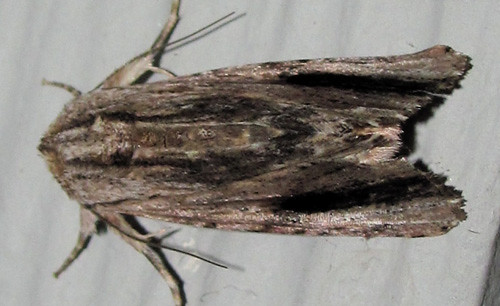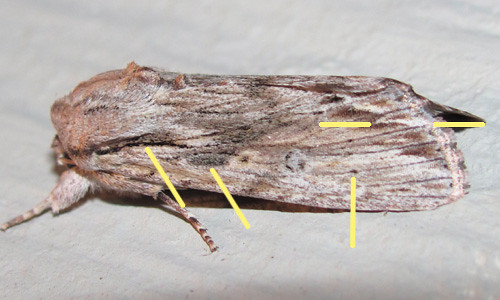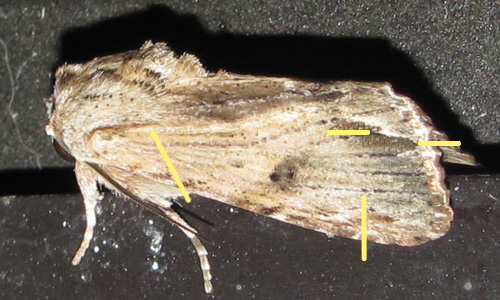ID Guide 1: Distinguishing Two Very Similar Armyworm Moths
Introduction
I tend to write up identification notes for myself as reminders on how to separate similar species...and then most often file these in a drawer somewhere until someone happens to ask about the same ID challenge. So, I'm going to attempt to begin posting a series of really miscellaneous Identification Guides to various tough moth identification challenges that I have encountered in Central Texas. With this limited geographic focus, some/many of these may not be relevant nor sufficient for ID help in a wider area, but hopefully they will offer starting points for consideration. All images are my own unless otherwise noted.
Two Similar Armyworm Moths
The Gray-streaked (or Unbarred) Armyworm (Spodoptera albula) and Southern Armyworm (Spodoptera eridania) occur across much of the southern U.S. They are superficially very similar. Both are paler and more uniformly patterned than a couple of their common relatives, the Fall Armyworm and Yellow-striped Armyworm.
Gray-streaked: http://mothphotographersgroup.msstate.edu/species.php?hodges=9673
Southern: http://mothphotographersgroup.msstate.edu/species.php?hodges=9672
Fall: http://mothphotographersgroup.msstate.edu/species.php?hodges=9666
Yellow-striped: http://mothphotographersgroup.msstate.edu/species.php?hodges=9669
After examining a series of photographs taken in the Austin area in October-November 2012 as well as available online images and specimens at the University of Texas Insect Collection, I offer the following information on how to separate these with some small details visible in specimens or close-up photographs.
Typical pale adults of the two species share these overall general characters:
(1) Overall pale cream to whitish-gray ground color.
(2) A small reniform spot which is fairly well marked by black spots or smudging.
(3) A subterminal zigzag band of brown edged on the outer side by white.
(4) Usually have a post-median row or arc of small dark dots on each vein (sometimes absent/obscure).
(5) Pale puffy grayish-white thorax with several thin dark longitudinal lines.
(6) Both have typical “Spodoptera” forelegs with puffy gray pantaloons (heavily scaled tibia), pale gray first tarsus, and darker, banded or white-tipped 2nd-5th tarsi.
Here are examples of the typical pale adults of each species:


Above: Gray-streaked Armyworm Below: Southern Armyworm
Here’s what I’ve figured out for distinguishing pale adults of the two species. (See note below about dark morph [female?] Southern Armyworm Moths.)
White margin of subterminal brown band: Note that the forward points of this zigzag band (highlighted by white) are inbetween the veins, particularly the point I’ve highlighted, and the point where the white touches the outer wing margin is on a vein rather than inbetween the veins.
Post-median band of dots: This row of dots, when present, is typically less than half way from the reniform spot to the outer wing margin, usually about 1/3 to 2/5 of the way, i.e. closer to the reniform spot than the outer margin.
Claviform spot: This elongate spindle-shaped gray spot is almost always present just on the basal side of the small orbicular spot (cream-edged brown dot).
Basal wing dash: Best viewed from the side. Most Gray-streaked Armyworm Moths have a long black dash from the base of the forewing. This dash is gently curved downwards (towards the forward wing margin), ending near the claviform spot. A shorter thin dark line may or may not be present on the thorax*. When paired with this dark line on the thorax, the dash looks partially doubled as in this individual.
- This field mark is emphasized in a number of published guides and online keys, but it is so variable and subject to wear that it should be used only in conjunction with the other marks. In particular, it can be difficult to distinguish a single dark line (thoracic? or base of wing?) when viewed from directly above. A shadow of the thoracic “epaulet” (tegula) may also show on photos illuminated from above.
White margin of subterminal brown band: The forward points of this zigzag white band are on the veins, particularly the point I’ve highlighted, and the point where the outermost white touches the outer wing margin (that is, the distal point of the dark brown band) is inbetween veins rather than on a vein.
Post-median band of dots: This row of dark dots on the veins, more often present in this species, is typically at least half way from the reniform spot to the outer wing margin, and thus a bit closer to the outer margin.
Claviform spot: The elongate gray spot of the Gray-streaked Armyworm is absent in this species.
Basal wing dash: Most Southern Armyworm Moths have only the thin dark line on the thorax, making this a single shorter dark line. This is best viewed from the side; see note on this field mark under the Gray-streaked Armyworm, above.
A darkly streaked form (female?) of the Southern Armyworm Moth is more distinctive:

Southern Armyworm Moth, dark form
[Originally prepared for Austin Butterfly Forum, November 12, 2012; revised Dec. 2012, Mar. 2017.]









Comments
Magnificent! I'll definitely be coming back to this journal entry when I see observations of these Spodoptera.
Tagging a few of the other moth-ers so they can enjoy this as well:
@hughmcguinness @krancmm @annikaml
This is great Chuck! Thanks!
Nice work!
Once again I'm using this awesome comparison! Thanks!
Add a Comment